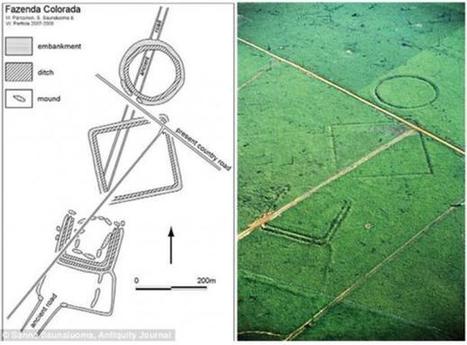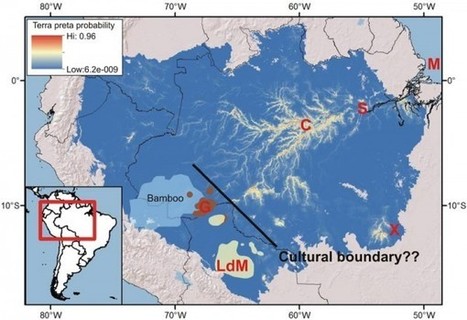Statistical model predicts signs of agriculture in the rainforest. A new model of the Amazon predicts that terra preta is more likely to be found along rivers in the eastern part of the rainforest. The letters indicate known archaeological sites.
Look around the Amazon rainforest today and it’s hard to imagine it filled with people. But in recent decades, archaeologists have started to find evidence that before Columbus’s arrival, the region was dotted with towns and perhaps even cities. The extent of human settlement in the Amazon remains hotly debated, partly because huge swaths of the 6-million-square-kilometer rainforest remain unstudied by archaeologists. Now, researchers have built a model predicting where signs of pre-Columbian agriculture are most likely to be found, a tool they hope will help guide future archaeological work in the region.
In many ways, archaeology in the Amazon is still in its infancy. Not only is it difficult to mount large-scale excavations in the middle of a tropical rainforest, but until recently, archaeologists assumed there wasn’t much to find. Amazonian soil is notoriously poor quality—all the nutrients are immediately sucked up by the rainforest’s astounding biodiversity—so for many years, scientists believed that the kind of large-scale farming needed to support cities was impossible in the region. Discoveries of gigantic earthworks and ancient roads, however, hint that densely populated and long-lasting population hubs once existed in the Amazon. Their agricultural secret? Pre-Columbian Amazonians enriched the soil themselves, creating what archaeologists call terra preta.
Terra preta—literally “black earth”—is soil that humans have enriched to have two to three times the nutrient content of the surrounding, poor-quality soil, explains Crystal McMichael, a paleoecologist at the Florida Institute of Technology in Melbourne. Although there is no standard definition for terra preta, it tends to be darker than other Amazonian soils and to have charcoal and pre-Columbian pottery shards mixed in. Most of it was created 2500 to 500 years ago. Like the earthworks, terra preta is considered a sign that a particular area was occupied by humans in the pre-Columbian past.
By analyzing location and environmental data from nearly 1000 known terra preta sites and comparing it with information from soil surveys that reported no terra preta, McMichael and her team found patterns in the distribution of the enriched soil. The scientists concluded that terra pretais most likely to be found in central and eastern Amazonia on bluffs overlooking rivers nearing the Atlantic Ocean. It’s less common in western Amazonia, where runoff from the Andes tends to add nutrients to the soil naturally, and in highland areas such as Llanos de Moxos in Bolivia, which is home to many impressive pre-Columbian earthworks. By analyzing the environmental conditions most strongly associated with terra preta, the team was able to build a model predicting where undiscovered terra preta sites are most likely to be found. Overall, they suspect that there is probably about 154,063 km2 of terra preta in the Amazon, composing about 3.2% of the basin’s total area, they report online today in the Proceedings of the Royal Society B.
Via
Dr. Stefan Gruenwald
 Your new post is loading...
Your new post is loading...











